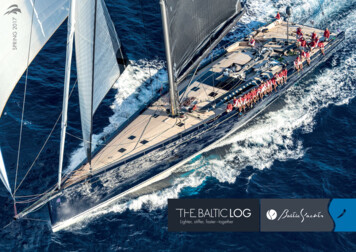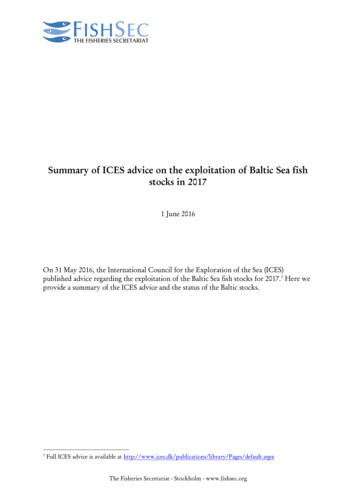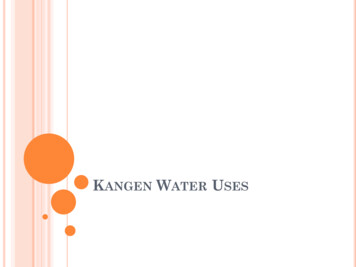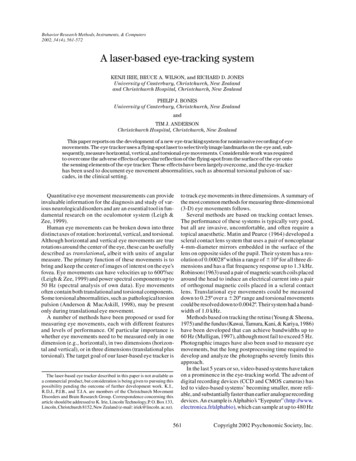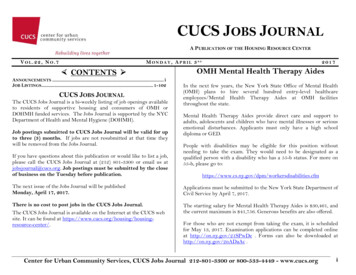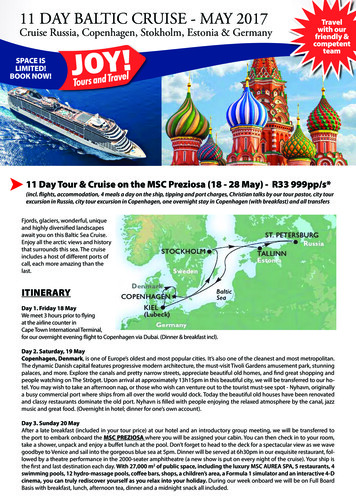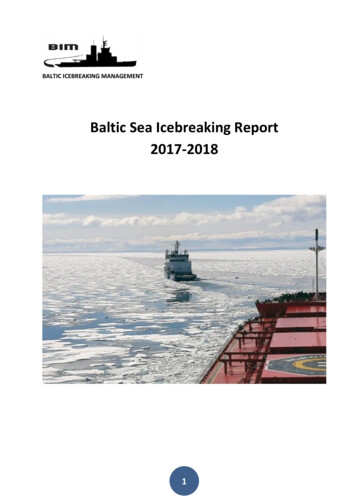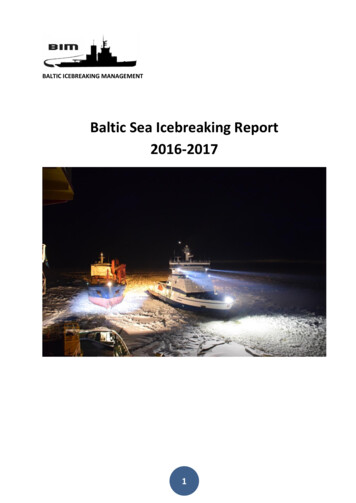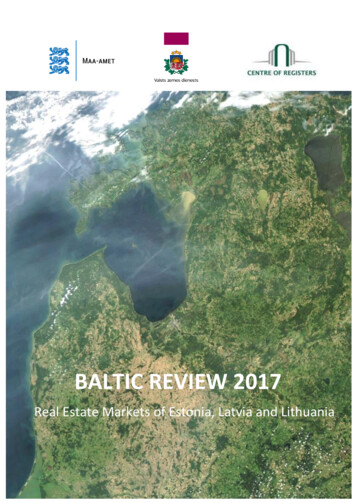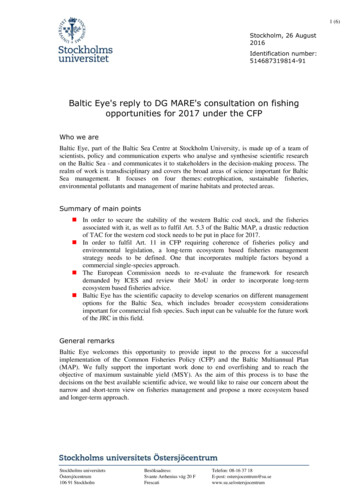
Transcription
1 (6)Stockholm, 26 August2016Identification number:514687319814-91Baltic Eye's reply to DG MARE's consultation on fishingopportunities for 2017 under the CFPWho we areBaltic Eye, part of the Baltic Sea Centre at Stockholm University, is made up of a team ofscientists, policy and communication experts who analyse and synthesise scientific researchon the Baltic Sea - and communicates it to stakeholders in the decision-making process. Therealm of work is transdisciplinary and covers the broad areas of science important for BalticSea management. It focuses on four themes: eutrophication, sustainable fisheries,environmental pollutants and management of marine habitats and protected areas.Summary of main points In order to secure the stability of the western Baltic cod stock, and the fisheriesassociated with it, as well as to fulfil Art. 5.3 of the Baltic MAP, a drastic reductionof TAC for the western cod stock needs to be put in place for 2017. In order to fulfil Art. 11 in CFP requiring coherence of fisheries policy andenvironmental legislation, a long-term ecosystem based fisheries managementstrategy needs to be defined. One that incorporates multiple factors beyond acommercial single-species approach. The European Commission needs to re-evaluate the framework for researchdemanded by ICES and review their MoU in order to incorporate long-termecosystem based fisheries advice. Baltic Eye has the scientific capacity to develop scenarios on different managementoptions for the Baltic Sea, which includes broader ecosystem considerationsimportant for commercial fish species. Such input can be valuable for the future workof the JRC in this field.General remarksBaltic Eye welcomes this opportunity to provide input to the process for a successfulimplementation of the Common Fisheries Policy (CFP) and the Baltic Multiannual Plan(MAP). We fully support the important work done to end overfishing and to reach theobjective of maximum sustainable yield (MSY). As the aim of this process is to base thedecisions on the best available scientific advice, we would like to raise our concern about thenarrow and short-term view on fisheries management and propose a more ecosystem basedand longer-term approach.Stockholms universitetsÖstersjöcentrum106 91 StockholmBesöksadress:Svante Arrhenius väg 20 FFrescatiTelefon: 08-16 37 18E-post: ostersjocentrum@su.sewww.su.se/ostersjocentrum
2 (6)In our reply we first focus on the necessity for extraordinary measures to secure the westernBaltic cod stock. The following section is on the process of setting fishing opportunities forthe region as a whole, bringing in strategic considerations.Western Baltic cod stockThe western Baltic cod is the most controversial fish stock when deciding Total AllowableCatches (TACs) for 2017 and for which opinions on appropriate management differ the mostbetween different stakeholders.Baltic Eye would like to stress that it is now crucial to take extraordinary measures foralleviating the poor state of the stock. Adjusting F levels to an MSY level would have beenpossible already when the revised CFP took effect in 2014. One of the consequences of nothaving done so can be the low stock size that we see today. We recommend that thecommercial catch in 2017 should be in accordance with the ICES MSY advice and not exceed917 tonnes (or in total 3475 tonnes when including recreational catches).During several consecutive years agreed TACs for the stock have exceeded the scientificadvice considerably. The improved assessment of the stock, provide by ICES last year,revealed that the biological reference points related to the risk of impaired reproductivecapacity of the stock (Blim and Bpa) was higher than previously estimated. ICES also adjustedthe spawning stock biomass (SSB) downwards and the fishing mortality rate (F) upwards.Even though the stock size has shown a small positive trend over the last year, it is still farbelow all biological reverence points (69% of Blim and 49% of Bpa /MSY Btrigger). In fact, thebiomass has been low since the early 1990’s, including the period of 2008-2013 when thestock was managed in accordance with the previous multiannual plan for the Baltic cod stock(COM 1098/2007). This indicates that the fishing pressure was too high during this period aswell.Especially worrisome was the historically low numbers of recruits (age 1 individuals) foundlast year. The number only made up 3,2 % of the average number of recruits for the period1994-present. Even though the reason for this is not totally clear, the relatively low watertemperatures of 2015 might be an obvious reason. This stresses the necessity to fine tune thescientific advice process to include more environmental factors, as we propose in the sectionbelow, and as is described in the ICES report from the workshop on developing integratedadvice for Baltic Sea ecosystem-based fisheries management (ICES 2016)1.1ICES. 2016. Report from the Workshop on Developing Integrated Advice for Baltic Sea Ecosystem-basedFisheries Management (WKDEICE), 18-21 April 2016, Helsinki, Finland. ICES CM 2016/SSGIE:13. 41 pp.
3 (6)Baltic Eye acknowledges the importance of ensuring opportunities and continuity for thefisheries industry and is aware of the short-term economic consequences that may occur dueto a drastic reduction of western cod TAC. However, under these circumstances thesustainability and future of the fish stock have to be prioritised in line with Art. 5.3 in theBaltic MAP. Also to ensure that the long-term economic opportunities for the fisheriesindustry are secured, in line with the ecosystem based fisheries approach under Art. 2.3 inCFP.Further, to ensure a recovery of the stock, it is necessary for the Member States to regulate therecreational fishery for cod in the area where western Baltic cod is distributed, in accordancewith preamble (3) of the CFP. This is partly needed due to the previous mismanagement of thestock by Member States, which over past years have repeatedly agreed on TACs that exceedthe scientific advice.Figure 1. Average Spawning Stock Biomass (upper panel) and average catch (lower panel) for the period1994-2005. From left to right the columns represent: observed values; modelled scenarios on: F MSY lower, FMSY and F MSYhigher. F MSY lower and F MSYhigher represent the lowest and highest values within the range ofF MSY, respectively (Ref EU 2016/1139).To illustrate the deviation between how the stock was actually managed for the period 19942015 (Fig.1 first bar from the left), compared with what would have been the stock size (SSB)and catches if an MSY approach would have been adhered to, we have run a basic agestructure model under different constant fishing mortality scenarios, that is: FMSY lower;FMSY and FMSY upper. As illustrated in the figure above, if an MSY approach had been
4 (6)adopted for the period, we would have at least the same catch as observed today or even muchhigher catches and a much higher fish stock. Thus, our models indicate that a fishery policysustaining both higher fish stocks and higher catches in the Baltic Sea are possible whenadopting a MSY approach.If drastic measures are not implemented now there is a risk that there will not only be longterm effects for the commercial fishing industry, as well as for recreational fisheries, but alsofor the whole ecosystem. The fact that cod, being the main predatory fish species, plays a keyrole in the Baltic Sea ecosystem is evident. This is true for both the western and eastern stock.Based on historical data strong variations in the eastern cod stock population size have resulted in clear regime shifts and ecological cascade-effects across the Baltic Sea ecosystem.Long-term ecosystem based strategy for the Baltic SeaFisheries management in the Baltic Sea must take greater account of environmental factors.The current structure lacks a mechanism for responding to large and sudden changes inecosystem conditions such as salinity that varies much more than in other European seas. TheBaltic Sea is an estuarine system with an upper layer of low salinity water and a deeper layerof high salinity water; the resulting strong vertical stratification acts like a strong lidpreventing exchange of oxygen. The extremely slow water exchange in combination withperennial human impact in the form of nutrient inputs driven by agricultural activities andsewage systems, makes the Baltic Sea especially sensitive for large scale oxygen depletionaffecting commercial fish species such as cod.The MAP is a tool for ensuring longer-term management of Baltic Sea fish stocks. But thescope is limited. It covers the commercially important fish stocks but only marginallyconsiders how these stocks affect each other. Further, the CFP only covers commerciallyimportant fish species and aims to secure the stock dynamic of these, irrespective of otherspecies important for the Baltic Sea ecosystem and for ensuring that the goals under theMarine Strategy Framework Directive (MSFD) are met.To be truly effective, fisheries management tools cannot be limited only to the fisheries sectorbut need to take broader environmental conditions (i.a. salinity, temperature and stratificationpatterns) and the effects of other drivers such as agriculture, industry, urban agglomerationsand economy into account.Thus, it would be advisable that ICES scientific advice on fishing opportunities includesecosystem variables to a further extent. To truly ensure this, an ecosystem approach needs tobe reflected in the MoU between the European Commission and ICES. Currently, thescientific advice given by ICES for Baltic Sea stocks consider single stock dynamics, nottaking into account environmental variables and only rarely relates to how fishing activitiesaffect the whole ecosystem. A more holistic and precautionary approach to fisheriesmanagement may complicate matters, especially policy responses, but is necessary if theoverall goal of Good Environmental Status for the Baltic Sea, in agreement with the MSFD, isto be attained. Further, this is important to ensure compliance with Art. 2.3. of the CFP onimplementation of the ecosystem based approach to fisheries management.
5 (6)At Baltic Eye we are working on an ecosystem model which includes various factorsinstrumental for Baltic Sea fish stocks, such as overall climate conditions, nutrient and trophicstatus, fishing pressure and marine protected areas. By combining these interdependent factorsand testing their impacts on the Baltic Sea food web at large and various fish stocks, differentscenarios can be compared to evaluate integrated management strategies for the Baltic Sea.Strategic cross-sectorial managementCurrent agricultural practices in the catchment area together with specific environmentalconditions such as stratification of water masses is a cause for large scale hypoxic areas whichis one of the most important factors influencing the size of fish stocks in the long-term. Thefish stock most sensitive to eutrophication is the eastern cod stock as they in youngdevelopmental stages primarily feed on bottom-living pray and are dependent on deeper welloxygenated areas for recruitment. Research shows that the extension of hypoxic areas limitcod growth and recruitment.Exponential increasein agricultureCurrent agricultural trendNutrients reduction10-15 yearsperspective80 yearsperspectiveFigure 2. Simulated Eastern Baltic cod stock biomass distribution. Colours of the map indicate relative codbiomass compared to initial value (red: higher, green: similar, blue: lower)Our analysis shows negative effects of the current nutrient management on the Baltic codstock. Managing fishing pressure, as is currently done, without incorporating a long-termperspective (10-15 years), and not taking into account elements such as nutrients input fromland and climate change, will pose a risk to attaining the expected goals foreseen under CFPand MAP. One of the simulation scenarios (Fig.2), which looks at fishing at FMSY underdifferent options of nutrients management, shows that even exploiting the cod stock at FMSY(according to MAP), may lead to a change in distribution and a drastic reduction of codbiomass with a potential future collapse.
6 (6)Baltic Eye sees a need for long-term cross-sectoral coordination, linking agriculturalmanagement with fisheries. Marine ecosystems are strongly related to catchment areas – andenvironmental management strategies of the catchment influences especially the Baltic Sea.Not taking agricultural effects, climate change and hydrographical conditions into account infisheries management is likely to contradict the goals under MSFD and thus riskscontradicting Art. 11 in CFP requiring coherence of fisheries policy and environmentallegislation.Integrated simulation scenarios can encompass wider factors, additional to single fish species,and thereby draw a longer-term picture of the ecosystem based effects of changing onecomponent in relation to another. As a policy tool this can be useful for decision-makers whenevaluating trade-offs and policy coherence between different legislative objectives that manytimes have different timeframes and scope for implementation.Tools available at the Baltic Sea Centre (models and scenarios) may help scientific advisorybodies as the Join Research Centre to deliver the best available scientific knowledge tosupport strategic planning and sound decisions for Baltic Sea management.Yours sincerely,Tina ElfwingChristoph HumborgDirector, Baltic Sea CentreScientific Director, Baltic Sea CentreFor further information, please contact:Gustaf Almqvist, marine ecologist and researcher at Baltic Eye, Baltic Sea Centre,gustaf.almqvist@su.seMaciej T. Tomczak, marine ecologist and researcher at Baltic Eye, Baltic Sea Centre,maciej.tomczak@su.se
opportunities for 2017 under the CFP Who we are Baltic Eye, part of the Baltic Sea Centre at Stockholm University, is made up of a team of scientists, policy and communication experts who analyse and synthesise scientific research on the Baltic Sea - and communicates it to stakeholders in the decision-making process. The

